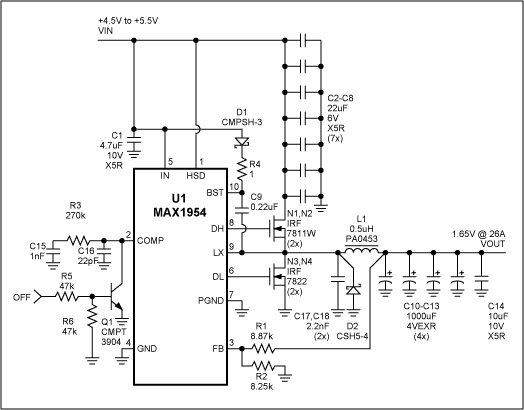Graphics Chip Supply Delivers 1.65V at 26A
要約
Game boxes are using more powerful processors to provide more realistic and complex graphics and games. As the processor power increases, so does the current required to power the parts. The MAX1954 in the application pictured below delivers 1.65V at 26A from a 5V input.
The MAX1954 is a 300kHz current-mode step-down controller. The MOSFET drivers are strong enough to handle 100nC gate charge. Given the nominal input and output voltages, the duty cycle is 33% and the on-resistance of the high- and low-side FETs are skewed accordingly. Two IRF7811W with 12mΩ on-resistance each are used for the high-side and two IRF7822 with 6.5mΩ on-resistance each are used for the low-side. Two IRF7811W in parallel have better switching characteristics than one IRF7822.
Seven 22µF/6V X5R ceramic capacitors are used for input bypassing to handle the 12.5ARMS input ripple current. At 5V input, ceramic capacitors are more cost effective and smaller than electrolytics. In addition, the MAX1954 senses current by looking at the voltage across the high-side FET on-resistance and ceramic bypass capacitors provide a better reference for the current-sense circuitry. A 2.2nF ceramic capacitor is included drain-to-source across each low-side FET to damp the parasitic ringing of the bond-wire inductance with the drain capacitance. This ringing can affect the current-sense circuitry.
The pulse engineering inductor is a custom part designed to handle 70A peak current without saturating. The MAX1954 uses a "valley" current limit based on the on-resistance of the low-side FET. The current limit is 200mV divided by the low-side FET on-resistance (3.3mΩ) plus the inductor ramp current (10A) which equals 70A. A 0.5µH/70A inductor is not readily available and a custom design is required to provide short-circuit protection.
The Sanyo output capacitors provide a good balance among ESR, ripple current rating, and cost. The capacitance is large enough for the output ripple to be dominated by the ESR. The application does not require low-profile.
The catch-diode, D2, limits the negative voltage of the LX node when the high-side FET turns off. In conjunction with R4, this controls the voltage on the boost capacitor, C8, at high-line and maximum output current. Without D2 and R4, the voltage on C8 can BST to LX absolute maximum voltage of 6V.
The MAX1954 delivers 1.65V at 26A from a 5V input. The efficiency is 86% at 26A and 90% at 10A. The output ripple is 25mVP-P.
| VIN | IIN | VOUT | IOUT | Efficiency |
| 5.0081 | 0.086 | 1.6663 | 0 | |
| 4.4905 | 11.13 | 1.6547 | 26 | 0.861 |
| 5.0125 | 9.95 | 1.6530 | 26 | 0.862 |
| 5.509 | 9.04 | 1.6513 | 26 | 0.862 |
| 25mVP-P |

Figure 1.
| Designation | Qty | Description |
| C1 | 1 | 4.7µF 10V X5R ceramic capacitor (1206) Taiyo Yuden LMK316BJ475ML |
| C2-C8 | 7 | 22µF 6V X5R ceramic capacitor (1210) Taiyo Yuden JMK325BJ226MN |
| C9 | 1 | 0.22µF ceramic capacitor (0603) |
| C10-C13 | 4 | 1000µF 4V aluminum electrolytic capacitor Sanyo 4MV1000EXR |
| C14 | 1 | 10µF 10V X5R ceramic capacitor (1210) Taiyo Yuden LMK325BJ106MN |
| C15 | 1 | 1nF ceramic capacitor (0603) Kemet C0603C102K8RAC |
| C16 | 1 | 100pF ceramic capacitor (0603) Kemet C0603C101K5GAC |
| C17, C18 | 2 | 2.2nF ceramic capacitor (0603) Kemet C0603C222K8RAC |
| D1 | 1 | 100mA 30V Schottky diode Central Semi CMPSH-3 |
| L1 | 1 | 0.5µH 30A Inductor Pulse Engineering PA0453 |
| N1, N2 | 2 | 12mΩ 30V N-ch MOSFET (SO-8) International Rectifier IRF7811W |
| N3, N4 | 2 | 6.5mΩ 30V N-ch MOSFET (SO-8) International Rectifier IRF7822 or Siliconix Si4842DY |
| Q1 | 1 | NPN Transistor (SOT-23) Central Semi CMPT3904 |
| R1 | 1 | 8.87kΩ 1% resistor (0603) |
| R2 | 1 | 8.25kΩ 1% resistor (0603) |
| R3 | 1 | 270kΩ 5% resistor (0603) |
| R4 | 1 | 1Ω 5% resistor (0603) |
| R5, R6 | 2 | 47kΩ 5% resistor (0603) |
| U1 | 1 | MAX1954EUB (10-µMAX®) |